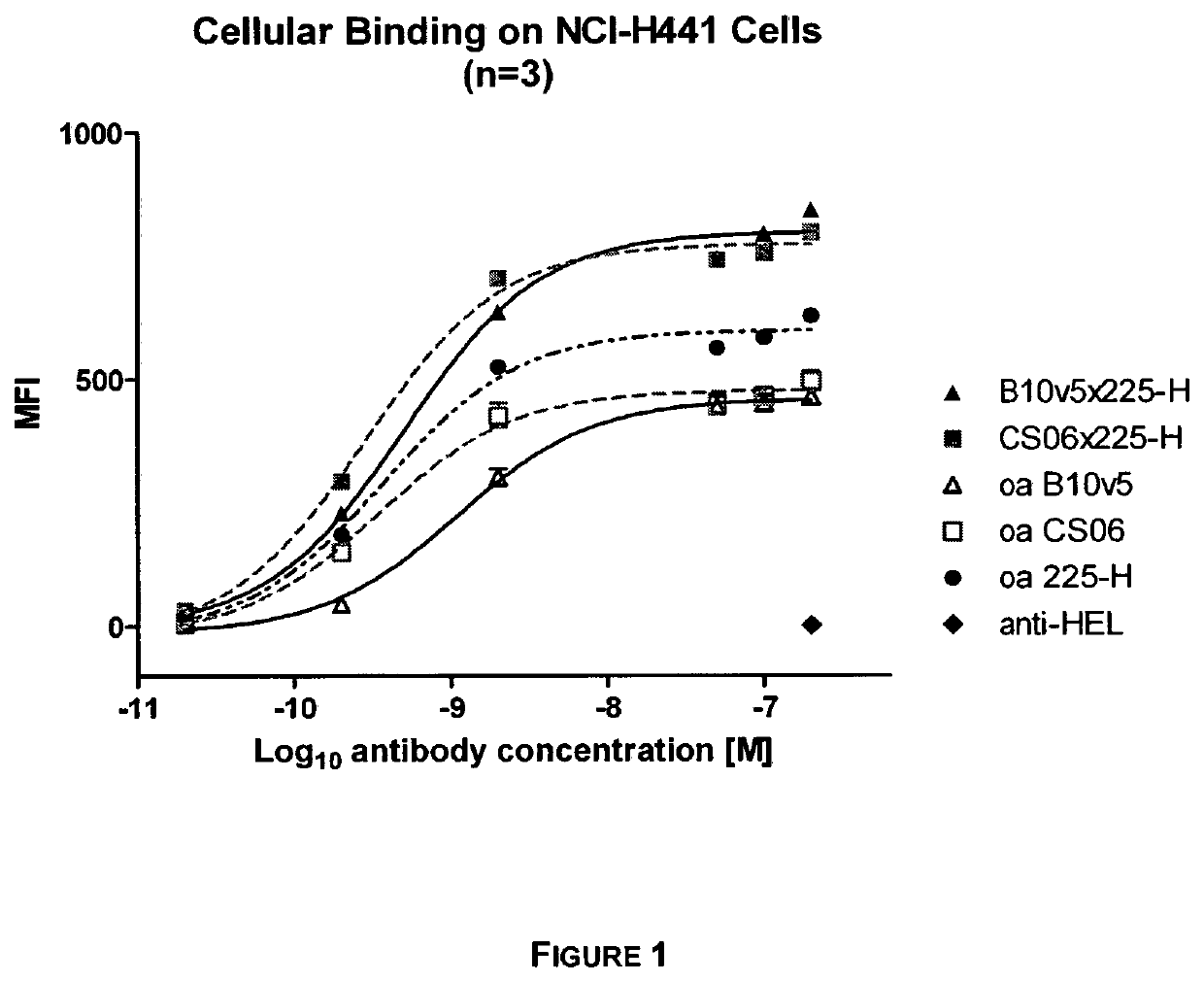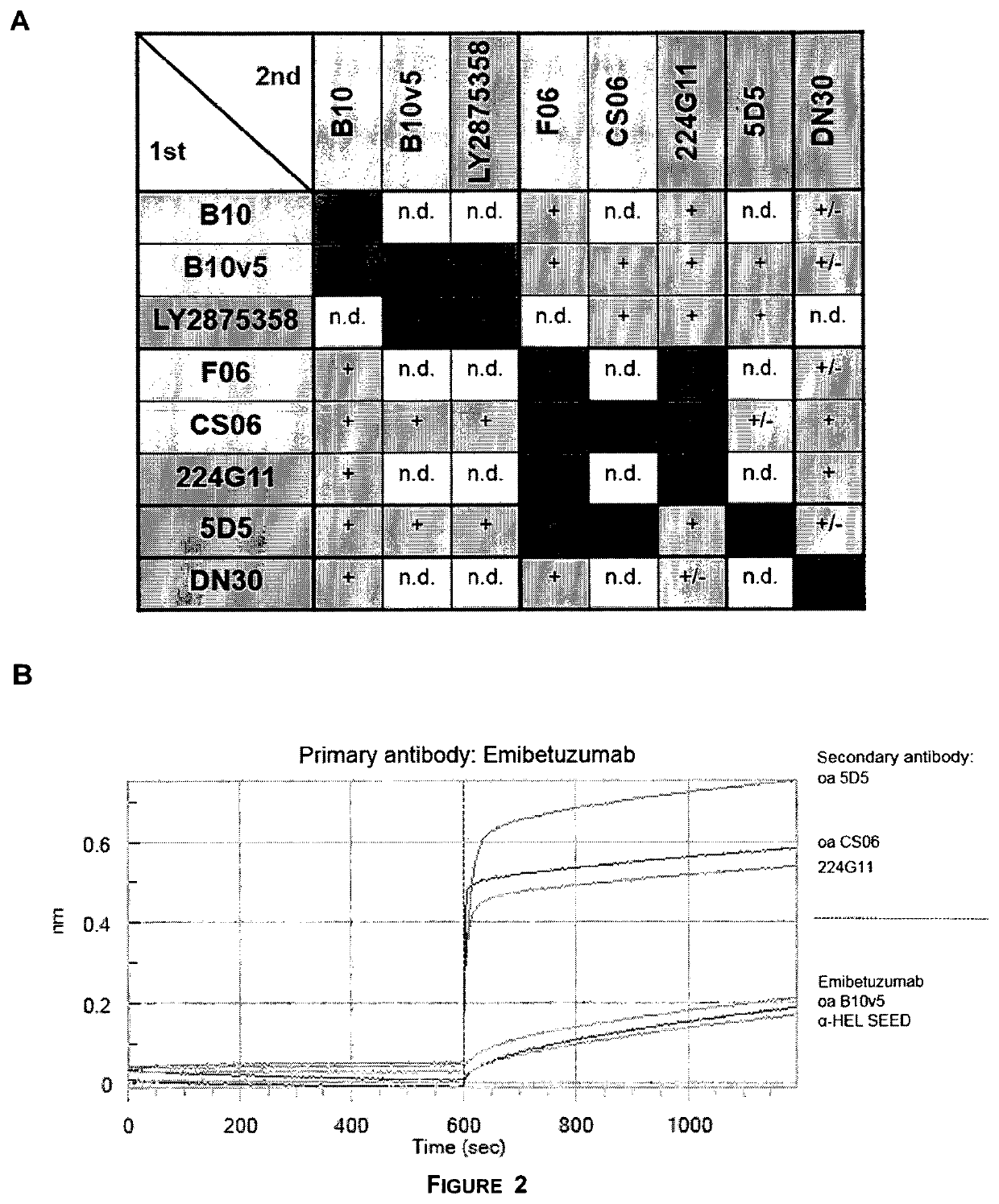Bi-specific antibodies for enhanced tumor selectivity and inhibition and uses thereof
a technology of specific antibodies and tumors, applied in the field of specific antibodies, can solve the problems of toxicities of therapies targeting egfr overexpressing cells
- Summary
- Abstract
- Description
- Claims
- Application Information
AI Technical Summary
Benefits of technology
Problems solved by technology
Method used
Image
Examples
example 1
n of Anti c-Met and Anti-EGFR Binders
[0137]Generation of c-MET Binders
[0138]Panning of naïve phage display antibody gene libraries HAL7 / 8 against human c-MET was performed according to Hust and colleagues. 36;37 Briefly, after pre-selection with panning buffer (1% skim milk powder, 1% BSA, 0.05% Tween® 20 in PBS) in maxisorp 96 well plates (Nunc), scFv displaying phages were selected on 1 μg immobilized c-MET-Fc (R&D Systems, 358-MT / CF) or c-MET SEMA domain (produced in house) and eluted with trypsin. After two to three rounds of panning, c-MET specific binders were enriched and screened by capture c-MET ELISA of produced scFv.
[0139]For affinity maturation, (a) error prone PCR for variable domains was performed using the GeneMorph II Random Mutagenesis Kits (Agilent Technologies) according to the manufacturer's instruction, (b) randomization of complementary-determining region three of the heavy chain (CDR-H3) ordered by GeneArt applying a parsimonious mutagenesis strategy 70, and (...
example 2
n and Purification of Bispecific c-MET×EGFR SEEDbodies
[0142]Several combinations of EGFR and c-MET antibody fragments according to the invention as disclosed herein were joined to bispecific antibodies using the SEED-technology.
[0143]Bispecific c-MET×EGFR SEEDbodies were expressed by transient transfection of Expi293F™ cells (human embryonic kidney cells) according to the manufacturer's instruction of the transfection kit (Invitrogen). Briefly, suspension Expi293F™ cells were cultured in Expi293F™ expression medium (Invitrogen) at 37° C., 5% CO2 and 180 rpm. On the day of the transfection, cells were seeded in fresh medium with a density of final 2×106 viable cells / ml. DNA-ExpiFectamine™293 reagent mixture diluted in Opti-MEM® I medium (Invitrogen) was added to the cells. 16 h post transfection, ExpiFectamine™293 transfection enhancer 1 and 2 were added. Cell supernatants containing secreted antibodies were harvested 5 days after transfection by centrifugation at 4,300×g, 4° C. and ...
example 3
f Bispecific c-MET×EGFR Antibodies to c-MET and EGFR on Cells
[0146]Bispecific c-MET×EGFR antibodies, one-armed (monovalent) control antibodies (anti-c-MET and anti-EGFR) as well as a non-related isotype control (anti-hen egg lysozyme, anti-HEL) were tested for their binding to c-MET and EGFR expressing NCI-H441 cells (as e.g. shown in FIG. 1, FIG. 15). NCI-H441 cells were detached with trypsin, centrifuged at 250×g for 10 min at 4° C. and resuspended in FACS buffer (1% BSA in 1×PBS). Cells were transferred to in 96 well round bottom plates at a density of 1×105 cells / well on ice. Purified c-MET×EGFR bispecific antibodies (0.02-200 nM) were added in FACS buffer in triplicates for 1 h on ice. Cells were centrifuged for 1000×g for 5 min at 4° C. and washed 3 times with 100 μl FACS buffer. Cells were incubated with 500 ng / well Fluorescein (FITC)-conjugated goat anti-human Fc gamma fragment IgG specific antibody (Jackson ImmunoResearch) diluted in FACS buffer on ice for 1 h. Cells were w...
PUM
| Property | Measurement | Unit |
|---|---|---|
| concentrations | aaaaa | aaaaa |
| diameter | aaaaa | aaaaa |
| diameter | aaaaa | aaaaa |
Abstract
Description
Claims
Application Information
 Login to View More
Login to View More - R&D
- Intellectual Property
- Life Sciences
- Materials
- Tech Scout
- Unparalleled Data Quality
- Higher Quality Content
- 60% Fewer Hallucinations
Browse by: Latest US Patents, China's latest patents, Technical Efficacy Thesaurus, Application Domain, Technology Topic, Popular Technical Reports.
© 2025 PatSnap. All rights reserved.Legal|Privacy policy|Modern Slavery Act Transparency Statement|Sitemap|About US| Contact US: help@patsnap.com



